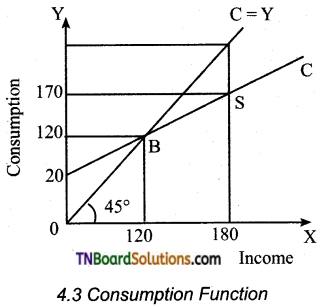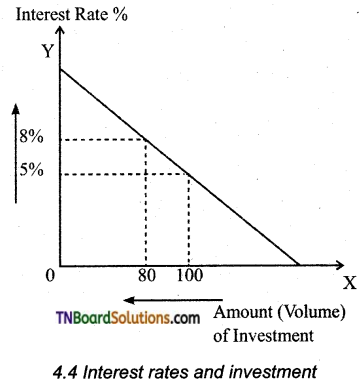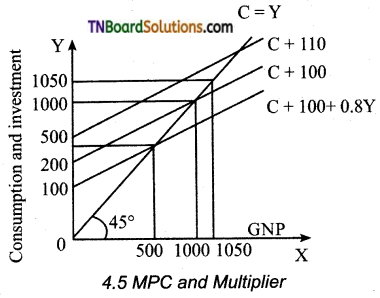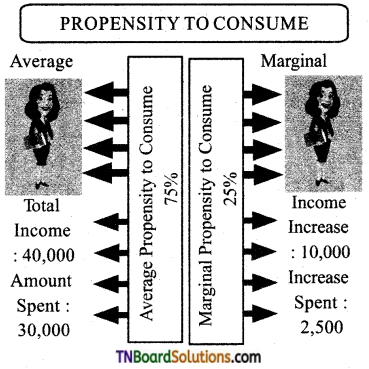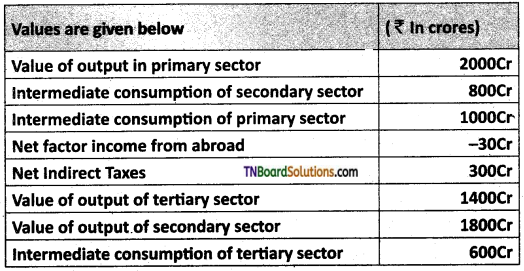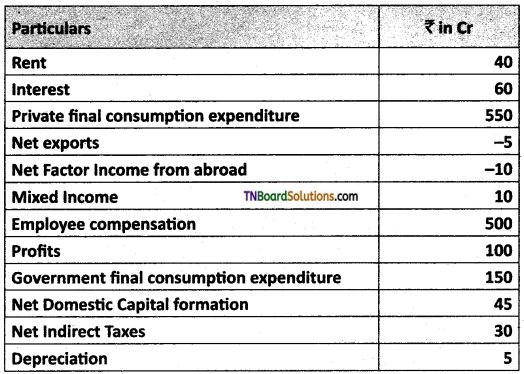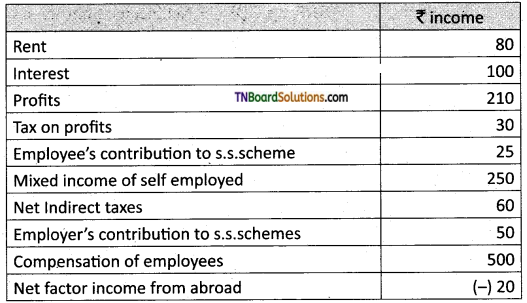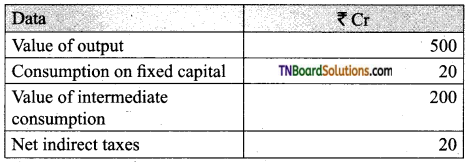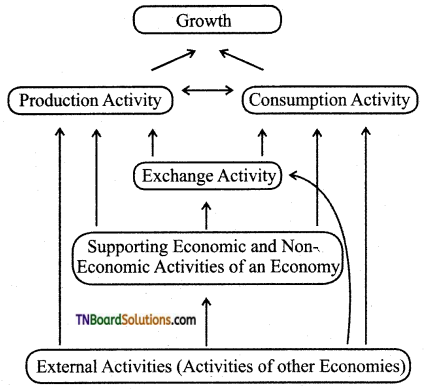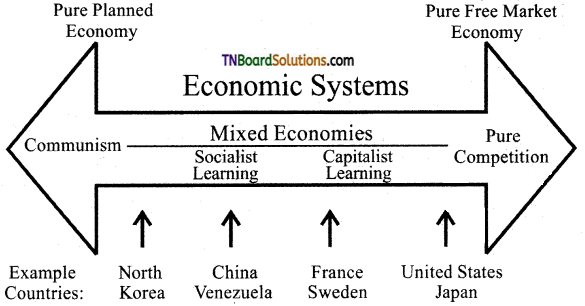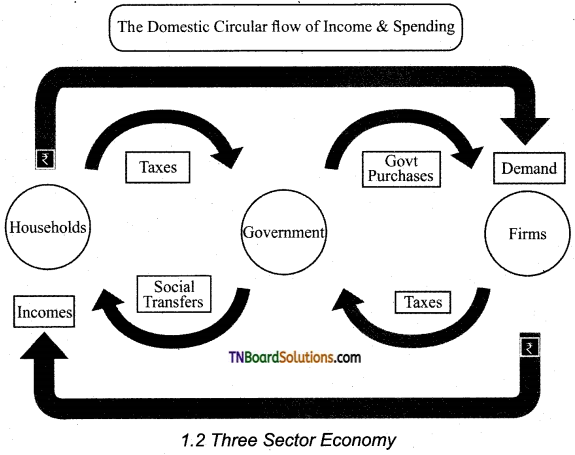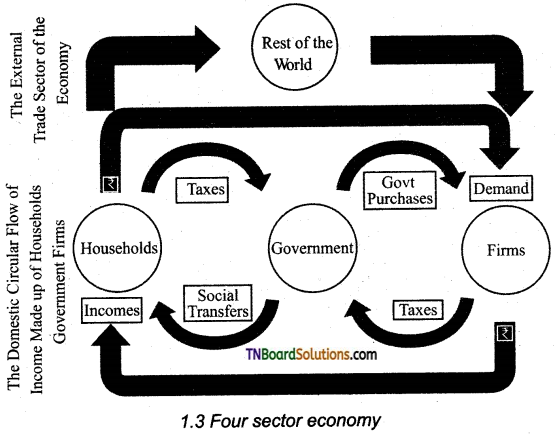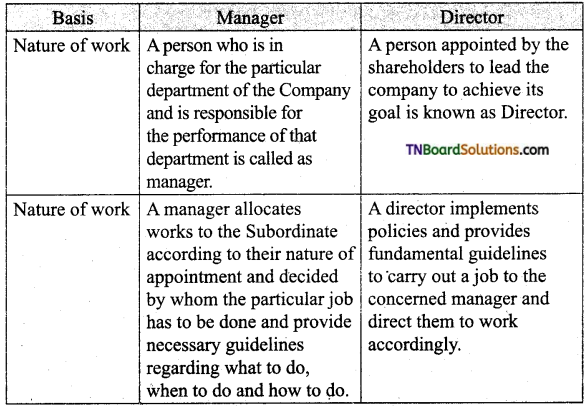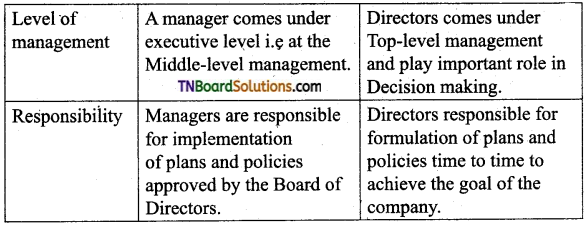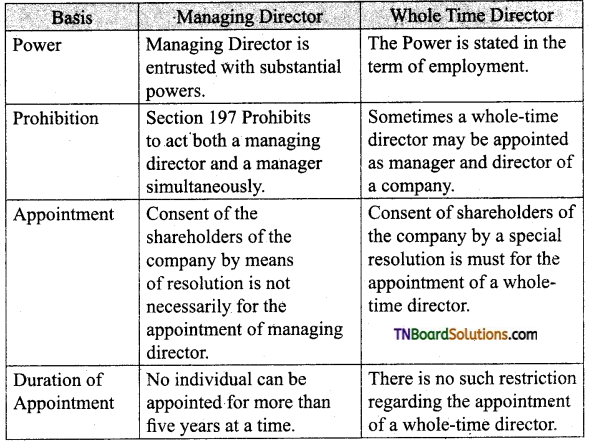Students get through the TN Board 12th Economics Important Questions Chapter 6 Banking which is useful for their exam preparation.
TN State Board 12th Economics Important Questions Chapter 6 Banking
Very short answer questions
Question 1.
Name the Central banks established between 1921 and 1954.
Answer:
- The South African Reserve Bank (1921)
- The Central Bank of China (1928)
- The Reserve Bank of India (1935)
- The Central Bank of Ceylon (1950)
- The Bank of Isreal (1954)
Question 2.
Write a note on primary deposits.
Answer:
Bank makes loans and advances to its customers out of these primary deposits. The initiative is taken by the customers. These deposits are also called “Passive deposits”
![]()
Question 3.
What do you mean by variable portfolio ceiling?
Answer:
The system by which the Central bank fixes the ceiling or maximum amount of loans and advances for every commercial bank.
Question 4.
What is a cheque?
Answer:
A cheque is an instrument that instructs the bank to transfer funds from the cheque issuer’s account to the receiver of the cheque.
Question 5.
Which monetary system does India follow?
Answer:
India follows the paper currency standard because in India, the standard currency is made of paper.
Question 6.
Why are financial institutions like UTI, LIC is not considered banks?
Answer:
Because such financial institutions do not accept chequable deposits.
Question 7.
Why are Post office savings banks are not treated as banks?
Answer:
Because they do not perform the bank’s essential functions of leading.
![]()
Question 8.
How NBFI are classified?
Answer:
Non-banking financial institutions are broadly classified into two. They are
- Stock exchange and
- Other financial institutions
Question 9.
What are the objectives of ARDC?
Answer:
- To provide necessary funds by way of refinancing to eligible institutions like Scheduled bank etc..
- To subscribe to the debentures floated by the Central land development banks etc.
Question 10.
What are the main objectives of RRBs?
Answer:
To provide credit and other facilities particularly to small and marginal farmers, agricultural laborers. So as to develop agriculture, trade industry and other production activities in Rural areas.
Question 11.
Write a note on a debit card.
Answer:
A debit card is a card allowing the holder to transfer money electronically from their bank account when making a purchase.
![]()
Short answer questions
Question 1.
What are the concessions of RRBs?
Answer:
Regional Rural Banks are granted concessions by the Central Banks
- They are allowed to maintain Cash Reserve Ratio at 3% and the Statutory Liquidity Ratio at 25%.
- RRBs also provide refinance facilities through NABARD.
Question 2.
What is the role of NABARD in agricultural credit?
Answer:
- The RBI has shown keen interest in agricultural credit and has maintained a separate department.
- RBI has extended short-term, medium and long-term credit to agriculture through state-level cooperative banks.
- RBI also set up Agricultural Refinance Development Corporation (ARDC) to promote agricultural development.
Question 3.
What are the two faces of monetary policy?
Answer:
Inflation: (cheap money policy)
- Borrowing is easy
- Consumer buy more
- Business expands
- More people are employed
- People spend more
Recession: (dear money policy)
- Borrowing is difficult
- Consumer buy less
- Business postpone expansion
- Unemployment increases
- Production is reduced
![]()
Question 4.
Distinguish between Demand deposits and time deposits.
Answer:
| Demand deposits | Time deposits |
| Demand deposits are payable on demand | Time deposits are payable on the expiry of specified period |
| It do not carry interest | This carry a fixed rate of interest |
| It is chequable deposits | It is not chequable deposits |
Question 5.
Write a note on e-banking.
Answer:
Online banking also known as internet banking is an electronic payment system that enables customers of a bank. The online banking system typically connects the core banking system operated by a bank and is in contrast to branch banking which was the traditional way customers accessed banking services.
Question 6.
Differentiate between NEFT and RTGS.
Answer:
There are two systems of inter-bank transfer. These systems are maintained by RBI.
| NEFT | RTGS |
| National Electronic Fund Transfer | Real Time Gross Settlement |
| Transaction happens in batches so its slow. | Transactions happens in real time so it is fast. |
| Timings 8 am to 6.30 pm | Timings 9 am to 4.30 pm |
| No minimum limit | Minimum amount for RTGS transfer is ?2 lakhs |
Question 7.
Write a note on Paytm.
Answer:
Payment Bank in August 2015, Paytm received a license from RBI to launch a payments bank. It is a separate entity in which founder Vijay Shekar Sharma will hold 51% share once communications hold 39% and 10% will be held by a subsidiary of one 97 and Sharma.
![]()
Question 8.
Write a note on the credit card.
Answer:
A credit card is a payment card issued to users to enable the cardholder to pay a merchant for goods and services based on the cardholder’s promise to the card issuer to pay them for the amounts, So paid-plus the other agreed charges. Credit cards combine with payment services with extensions of the credit card industry may limit customers’ ability to shopping.
Question 9.
Write a note on NPA.
Answer:
Non-Performing Asset. Once the borrower fails to make interest or principal payment for 90 days, the loan is considered to be a Non-Performing Asset. They depend on interest payment for income. The size of NPA is around 10 lakhs cr. So the government is forced to infuse capital to the banks by using poor Taxpayers’ money. The government of India has infused Rs. 68000 cr to the banking system. So the NPAs ultimately affect the common people.
Question 10.
Write a note on the merger of banks.
Answer:
Union cabinet decides to merge all the remaining five associate banks of the State Bank group with SBI in 2017. Five associates and the Bharatiya Mahila Bank have become part of SBI on April 1, 2017. This has placed SBI among the top 50 banks in the world. The five associate banks that were merged are
- State Bank of Bikaner and Jaipur (SBBJ)
- State Bank of Hyderabad (SBH)
- State Bank of Mysore (SBM)
- State Bank of Patiala (SBP) and
- State Bank of Travancore (SBT).
![]()
Long answer questions
Question 1.
Explain industrial credit and investment Cooperation of India.
Answer:
Functions:
- Assistance to industries
- Provision of foreign currency loans
- Merchant banking
- Letter of credit
- Project promotions
- Housing loans
- Leasing operation
This was set up on 5th Jan 1955. The purpose is to channelize the World bank funds to the industry in India and also help to build up a Capital market. Now a very large part of its equity capital is held by Public sector Institutions such as HC, GIC. The feature of the operation of ICICI is the foreign currency loans sanctioned by this institution of industries. Since 1973, the ICICI has entered the international capital markets also for raising foreign currency loans. ICICI also borrows from IDBI and the Government sector. The major portion of its assistance has gone to the private sector.
Question 2.
Explain IDBI – Industrial Development Bank of India.
Answer:
The IDBI was a wholly-owned subsidiary of RBI till 1976 and it was delinked and made an autonomous corporation, fully owned by the Government of India. The functions are
- Assistance to other Financial institutions.
- Direct assistance to industrial concerns. It can provide refinance in respect of term loans to IFC, SFC. The special feature of IDBI is the provision for the creation of a special fund known as the Development assistance fund. It provides assistance to industries. The financing of Exports was also undertaken by IDBI till the establishment of Exim bank in 1982.
![]()
Question 3.
Explain the State Level Institutions.
Answer:
The Government of India passed SFC Act in 1951. It is for the development of small and medium Industries. The SFC provides loans and assistance to industrial units. The maximum amount that can be sanctioned to the industry is up to 60 lakhs. SFC depends upon the IDBI for refinancing. It can also make temporary borrowings from RBI.
Question 4.
State Industrial Development Corporation (SIDCO).
Answer:
It was set up by the state governments. They provide financial assistance to industrial concerns by way of loans, promotional activities such as surveys, project identification, and training of entrepreneurs. SIDCO takes 26%, 25% of the equity, and the rest is offered to invest public. SIDCO also administers various government incentive schemes. They also borrow through bonds and accept deposits.
Activity
Question 1.
Students are to be asked to visit the nearby commercial bank to observe the functioning of the bank. They are also instructed to submit a brief report about their learning experiences.
Answer:
Visit a Commercial Bank: To know the functions of the Bank.
- Helps to know and have a deep understanding of the functioning of Banks.
- Students can perform Banking activities of their own.
- Students will know and observe the day-to-day activities of a Bank.
- Helps to develop a deep understanding of the Banking system.
- Finally, students understand that Banking is much a part of human life.
- They also understand the essence and importance of Banking.
![]()
Question 2.
Students are asked to do a brief survey about the impact of the 2016 Demonetisation of currency on the general public.
Answer:
Students as the first step can take interviews with their family members. Inference of Survey:
- How public or the family members faced difficulties in changing 500 and 1000 Notes.
- What are the difficulties they faced in ATM to withdraw the money for day to expenses?
- The difficulties they faced in standing and waiting in front of ATMs and Banks.
- The difficulties they faced especially when there was a family get-together or function.
- The problems faced by the public during their travel.
Students will gather information from nearby areas, petty shops, and street vendors.
Multiple choice questions
1. When was the oldest Central bank in the world established?
(a) 1686
(b) 1656
(c) 1676
(d) 1666
Answer:
(b) 1656
2. Where was the international finance conference held in 1920?
(a) Russia
(b) USA
(c) South Africa
(d) Brussels
Answer:
(d) Brussels
![]()
3. The functions of commercial banks are broadly classified into:
(a) Three
(b) Four
(c) Two
(d) Five
Answer:
(a) Three
4. There are ……… types of deposits.
(a) 2
(b) 3
(c) 4
(d) 5
Answer:
(a) 2
5. Commercial banks help in providing foreign exchange to businessmen dealing with:
(a) Trade
(b) Money
(c) Industries
(d) Import and export
Answer:
(d) Import and export
6. Pooled savings should be allocated to various sectors of the economy with a view to increase:
(a) Consumption
(b) Production
(c) Distribution
(d) Exchange
Answer:
(b) Production
7. When was there an economic crises in US?
(a) In 2006 – 2007
(b) In 2004 – 2005
(c) In 2007 – 2008
(d) In 2001 – 2002
Answer:
(c) In 2007 – 2008
![]()
8. RBI has given ……….. crores to the Government of India in the year 2018 – 2019
(a) Rs. 60,000
(b) Rs. 78,000
(c) Rs. 63,000
(d) Rs. 68,000
Answer:
(d) Rs. 68,000
9. Banks provide ……….. credit for worthwhile projects.
(a) 90%
(b) 100%
(c) 80%
(d) 75%
Answer:
(b) 100%
10. RBI was Nationalized on:
(a) 1947
(b) 1949
(c) 1948
(d) 1946
Answer:
(b) 1949
11. …………. is the sole authority to issue currency.
(a) RBI
(b) SBI
(c) ICICI
(d) All the banks
Answer:
(a) RBI
12. According to sec 22 of ……….. every bank should obtain Banking License from RBI.
(a) Monetary policy
(b) Fiscal policy act
(c) Bank of India act
(d) Banking Regulation act
Answer:
(d) Banking Regulation act
![]()
13. RBI represents India as a member of:
(a) SBI
(b) FEMA
(c) FOREX
(d) IMF
Answer:
(d) IMF
14. Banking Regulation Act of in the basis for credit control of RBI.
(a) 1949
(b) 1959
(c) 1939
(d) 1929
Answer:
(a) 1949
15. The RBI was providing medium-term loans also for a period exceeding ……….. for reclamation of land.
(a) 15 months to 5 years
(b) 15 months to 3 years
(c) 15 months to 2 years
(d) 15 months to 5 years
Answer:
(d) 15 months to 5 years
16. RBI relating to agriculture credit has been over by ……….. since 1982.
(a) NABARD
(b) ARDC
(c) IMF
(d) ICICI
Answer:
(a) NABARD
![]()
17. ARDC was established on 1st July 1963.
(a) Act of RBI
(b) Act of Government
(c) Act of Parliament
(d) Act of Scheduled bank
Answer:
(c) Act of Parliament
18. NABARD gives long-term loans up to years to the state government.
(a) 20
(b) 30
(c) 10
(d) 40
Answer:
(a) 20
19. The planning commission now:
(a) NABARD
(b) RRB
(c) NITI Aayog
(d) SCB
Answer:
(c) NITI Aayog
20. IFCI was established .in:
(a) 1938
(b) 1948
(c) 1958
(d) 1968
Answer:
(b) 1948
21. Financial assistance of IFCI can be availed by any:
(a) Bank
(b) Public sector
(c) Limited company
(d) Industry
Answer:
(c) Limited company
![]()
22. ICICI was set up in 1955 as:
(a) Limited company
(b) Bank
(c) Public sector
(d) Joint-stock company
Answer:
(d) Joint-stock company
23. IDBI was delinked from RBI and became autonomous from the year:
(a) 1966
(b) 1976
(c) 1986
(d) 1956
Answer:
(b) 1976
24. The maximum amount that can be sanctioned to industry by SFC is:
(a) 20 lakhs
(b) 30 lakhs
(c) 60 lakhs
(d) 50 lakhs
Answer:
(c) 60 lakhs
25. ………… received Nobel prize in 1976 and introduced the doctrine of monetarism.
(a) Adam smith
(b) Alfred Marshall
(c) Lionel robbins
(d) Milton Friedman
Answer:
(d) Milton Friedman
26. ATM was introduced in:
(a) 1947
(b) 1957
(c) 1967
(d) 1977
Answer:
(c) 1967
![]()
27. ……… was the founder of Paytm Payments Bank.
(a) Milton Friedman
(b) Vijay Mallya
(c) Vijay Shekar Sharma
(d) Rakesh Sharma
Answer:
(c) Vijay Shekar Sharma
28. Demonetisation occurs whenever there is a change in:
(a) Government
(b) Political party
(c) Exchange rate
(d) National currency
Answer:
(d) National currency
29. Which of the following makes a financial institution a bank?
(a) Accepting deposits
(b) Lending
(c) Accepting demand deposits
(d) Accepting time deposits
Answer:
(c) Accepting demand deposits
30. Creation of money by commercial banks refer to:
(a) Creation of bank deposits
(b) Issuing currency
(c) Both (a) and (b)
(d) None
Answer:
(a) Creation of bank deposits
31. How much money are banks able to create is determined by?
(a) Initial deposits
(b) SCR
(c) CRR
(d) All the above
Answer:
(d) All the above
![]()
32. Given CRR=4% and SLR=16% the value of multipliers is:
(a) 25
(b) 6.25
(c) 5
(d) 8.33.
Answer:
(c) 5
33. When the Central bank sells securities in the market, the credit creation capacity of the commercial banks is like to:
(a) Rise
(b) Fall
(c) Rise or fall
(d) No effect
Answer:
(b) Fall
34. Raising Reverse Repo Rate by the central bank is likely to have the following impact on demand for goods and services in the economy:
(a) Rise
(b) Fall
(c) May rise and fall
(d) No effect
Answer:
(a) Rise
35. With lowering requirements by the central bank, the borrowing capacity of the borrowers:
(a) Rises
(b) Falls
(c) May rise and fall
(d) No effect
Answer:
(a) Rises
36. Which of the following is a bank?
(a) Post office savings bank
(b) LIC
(c) UTI
(d) IDBI
Answer:
(a) Post office savings bank
![]()
37. Finance is the essential breath of all economic activities:
(a) Trade
(b) Commerce
(c) Agriculture
(d) Collecting cheques
Answer:
(d) Collecting cheques
Pick the odd one out.
1. Commercial banks collect:
(a) Dividends
(b) Pensions
(c) Salaries
(d) Tax
Answer:
(d) Tax
2. Commercial banks make the payments of various obligations of customers such as:
(a) Telephone bills
(b) Rent
(c) Household equipment
(d) School fees
Answer:
(c) Household equipment
3. Commercial banks provide locker facilities to their customers for the safe custody of:
(a) Customers
(b) Jewellery
(c) Shares
(d) Debentures
Answer:
(a) Customers
![]()
4. Banks collect and publish statistics relating to:
(a) Population
(b) Trade
(c) Commerce
(d) Industry
Answer:
(a) Population
5. NBFs other financial institutions category comes:
(a) RBI
(b) Chit funds
(c) Unit trust
(d) Insurance companies
Answer:
(a) RBI
6. Monetary authority controls the supply of money in the economy to stabilize:
(a) Population
(b) Control inflation
(c) Banking system
(d) Exchange rate
Answer:
(a) Population
7. Statutory Liquidity Ratio is the amount which a bank has to maintain in the form of:
(a) Legal tender
(b) Cash
(c) Gold
(d) Approved securities
Answer:
(a) Legal tender
![]()
8. Moral suasion under this method Central bank gives ……….. to Commercial banks to co-operate.
(a) Advice
(b) Requests
(c) Persuades
(d) Notice
Answer:
(d) Notice
9. Economists are the chief exponents of Neutral money.
(a) Adam smith
(b) Wicksteed
(c) Hayek
(d) Robertson
Answer:
(c) Hayek
10. The objectives of demonetization:
(a) Removing black money from the currency
(b) Issuing the currency notes
(c) Stopping corruption
(d) Stopping terror funds
Answer:
(d) Stopping terror funds
![]()
11. Credit creation leads to increase:
(a) Production
(b) Public finance
(c) Employment
(d) Sales
Answer:
(b) Public finance
